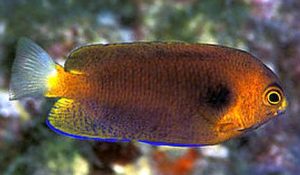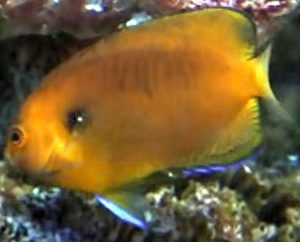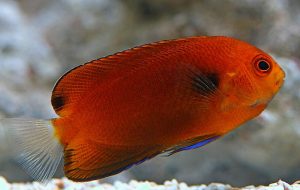The Fisher’s Angelfish (Centropyge fisheri) known to tropical fish keeping enthusiasts as the Orange Angelfish, Fisher’s Dwarf Angelfish, and Fisher’s Pygmy Angelfish is endemic to the Hawaiian Islands and Johnston Atoll in the Central Pacific Ocean.
Fisher’s Angelfish are collected around coral rubble on seaward slopes at depths between 30 and over 250 feet where they graze on algae, small worms, and crustaceans.
Fisher’s Angelfish are one of the smallest Centropyge species and are sought after by tropical fish keeping enthusiasts for integration into small tanks and nano style systems.
Although they are closely related to the mostly blue Pacific Whitetail Angelfish (Centropyge flavicauda) and have been artificially hybridized with them; Fisher’s Angelfish are a golden orange brown color with black flecks on the upper half of the body and subtle vivid blue markings on the outside edges of the dorsal, anal, pelvic, and caudal fins. A black spot accents the body just above the pectoral fins.
Like all Centropyge species, Centropyge fisheri begin life as unsexed individuals, but as they grow they start their adult life as females. The larger or more dominant individual within a small group will change sex within a few days to several weeks and become a male.
Sexing Fisher’s Angelfish cannot be done by color. The main difference between sexes is size.
To obtain a pair, place two different sized specimens into a tank and within 60 days or so, one of the fish will physically change it’s sex to accommodate the other.
Fisher’s Angelfish are quite social and get along well with a variety of species of the same size and demeanor. They do best in an aged, well established aquarium of at least 30 gallon capacity with an abundance of live rock arranged into small crevices, overhangs, and caves for them to explore and hide among with they feel threatened. They do exceptionally well in a reef tank but have a tendency to mess with clam mantles, sea anemones, large and small–polyped stony (LPS/SPS) corals, and small crustaceans, when underfed.
Although Centropyge fisheri do well in a “community” type setup, like all Pygmy Angelfish, they can be aggressive and intolerant of their own species or any other fish of similar color or shape. You can count on them becoming aggressive when housed with other dwarf angelfish species.
Fisher’s Angelfish have not successfully been bred in an aquarium environment but have been hybridized with Centropyge flavicauda.
In their natural environment, Fisher’s Angelfish feed on microalgae, diatoms, worms and small crustaceans. In an aquarium environment containing copious amounts of live rock, it is important that they are fed a varied diet of Spirulina, marine algae, brine shrimp, mysis, any one of the many commercial high quality angelfish preparations containing sponges, and other meaty foods. This species does best when fed several times a day.
Fisher’s Angelfish (Centropyge fisheri) are available to tropical fish keeping enthusiasts from a variety of sources online at reasonable prices at approximate purchase sizes of: Small: 3/4 inch to 1 inch, Medium: 1 inch to 2 inch, Large: 2 inch to 3 inch
Minimum Tank Size: 30 gallons
Aquarium Type: Community or Reef with caution
Care Level: Moderate
Temperament: Semi-aggressive
Aquarium Hardiness: Very Hardy
Water Conditions: 68-79° F, 8 to 12 dGH , pH 8.0 – 8.5, sg 1.020-1.026
Max. Size: 2.5″
Color Form: Brown, Blue, Orange
Diet: Omnivore
Compatibility: Single species
Origin: Indo-Pacific as far north as the Hawaiian Islands
Family: Pomacanthidae
Lifespan: 5-7 years
Aquarist Experience Level: Intermediate





